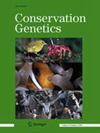Functional connectivity in northern swamp deer (Rucervus duvaucelii duvaucelii) population across a fragmented, human-dominated landscape along Gangetic Plains of north India: implications for conservation in non-protected areas
IF 1.7
3区 环境科学与生态学
Q2 BIODIVERSITY CONSERVATION
引用次数: 0
Abstract
The Indian subcontinent has witnessed disproportionate declines in large mammalian herbivore communities. The northern swamp deer (Rucervus duvaucelii duvaucelii) exemplifies the conservation challenges of typical non-protected area species, where apart from distribution status other ecological information is limited for the upper Gangetic basin population. We combined elements of radio-telemetry and conservation genetics to evaluate dispersal patterns, population connectivity and assess genetic variation and inbreeding status of this population living across a highly human-dominated area. We genetically identified 266 unique swamp deer and further analyses revealed presence of two spatially-admixed genetic lineages with moderate heterozygosity (Ho=0.51, SD = 0.10) and low inbreeding (FIS = 0.128) status. Multidisciplinary evidence suggests that the small, isolated grassland patches between Jhilmil Jheel Conservation Reserve (JJCR) and Hastinapur Wildlife Sanctuary (HWLS) are highly preferred by swamp deer during migrations and are genetically connected. The southern part of the area in HWLS showed early signatures of genetic discontinuity that require immediate conservation attention. We hypothesized that the human settlement history of this landscape, river dynamics and species’ ability to negotiate various pressures and disperse has helped to maintain such connectivity. While these signatures are encouraging for this small, isolated cervid population, careful management interventions are required to ensure the integrity and functionality of this landscape. We recommend a scientifically robust population estimation approach across this landscape and multi-stakeholder-driven strategies to augment population and habitat recovery, combat poaching, plantation and riverscape management to ensure long-term survival of this species.

印度北部恒河平原人类主导景观中北部沼泽鹿(Rucervus duvaucelii duvaucelii)种群的功能连通性:对非保护区保护的启示
印度次大陆的大型食草哺乳动物种群数量出现了不成比例的下降。北部沼泽鹿(Rucervus duvaucelii duvaucelii)是典型的非保护区物种保护挑战的例证,除了分布状况外,恒河上游流域种群的其他生态信息有限。我们结合无线电遥测和保护遗传学的元素来评估分布模式,种群连通性,评估遗传变异和近交状况,这些种群生活在高度人类主导的地区。对266只沼泽鹿进行了遗传鉴定,并进一步分析发现存在两个空间混合遗传系,它们具有中等杂合度(Ho=0.51, SD = 0.10)和低近交系(FIS = 0.128)。多学科证据表明,在Jhilmil Jheel保护区(JJCR)和Hastinapur野生动物保护区(HWLS)之间的小而孤立的草地斑块是沼泽鹿在迁徙期间的高度偏好,并且具有遗传联系。该地区在HWLS的南部显示出遗传不连续性的早期特征,需要立即予以保护。我们假设,这一景观的人类定居历史、河流动态和物种应对各种压力和分散的能力有助于保持这种连通性。虽然这些特征对这个小而孤立的鹿群来说是令人鼓舞的,但需要仔细的管理干预来确保这一景观的完整性和功能性。我们建议采用科学可靠的种群估计方法和多方利益相关者驱动的战略,以增加种群和栖息地的恢复,打击偷猎,种植和河流景观管理,以确保该物种的长期生存。
本文章由计算机程序翻译,如有差异,请以英文原文为准。
求助全文
约1分钟内获得全文
求助全文
来源期刊

Conservation Genetics
环境科学-生物多样性保护
CiteScore
3.80
自引率
4.50%
发文量
58
审稿时长
1 months
期刊介绍:
Conservation Genetics promotes the conservation of biodiversity by providing a forum for data and ideas, aiding the further development of this area of study. Contributions include work from the disciplines of population genetics, molecular ecology, molecular biology, evolutionary biology, systematics, forensics, and others. The focus is on genetic and evolutionary applications to problems of conservation, reflecting the diversity of concerns relevant to conservation biology. Studies are based on up-to-date technologies, including genomic methodologies. The journal publishes original research papers, short communications, review papers and perspectives.
 求助内容:
求助内容: 应助结果提醒方式:
应助结果提醒方式:


